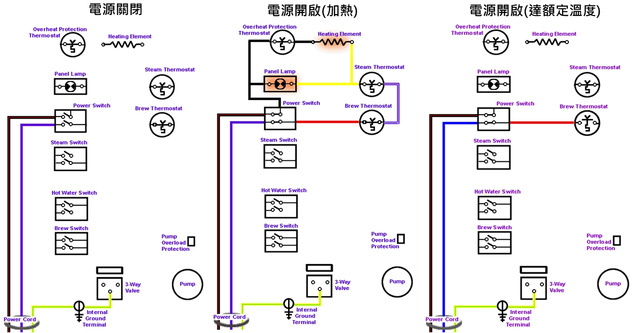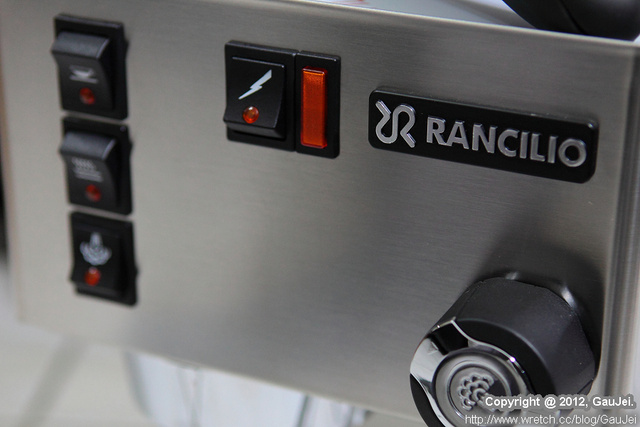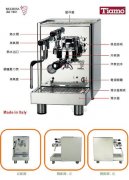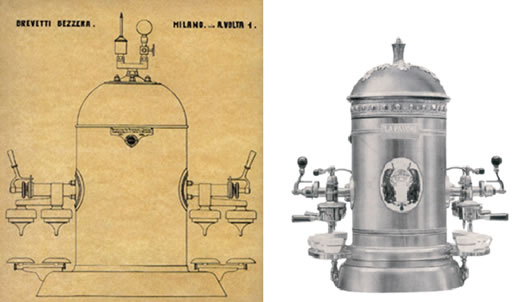The structure and principle of household Italian coffee machine which brand of coffee machine is good and how to repair it?
For professional baristas, please follow the coffee workshop (Wechat official account cafe_style)
The origin of the Expresso coffee machine (Espresso means "fast" in Italian) can be traced back to 1901, when the Italian manufacturing boss (Luigi Bezzera) invented the coffee machine in order to reduce the time employees spent cooking and waiting for coffee, in order to increase work efficiency. At that time, coffee was quickly extracted by high-pressure cooking, and the machine for making coffee was also patented. At that time, the machine was called Tipo Gigante. This machine accelerates the time of making coffee because of high pressure extraction, but it tastes bitter. Four years later, Desiderio Pavoni bought the patent of Luigi Bezzera coffee machine, and after continuous tests and experiments, he came to the final conclusion that the bitter coffee made by this machine was caused by the high temperature. After numerous experiments and verification, we finally found the best parameters for cooking coffee: 90.56 degrees Celsius hot water with a pressure of 8-9 Bar.
What really makes Espresso flourish is the United States, because American coffee chains began to use Espresso machines to make espresso to make a variety of coffee drinks in 1990. Because of the rise of coffee chains in China, people gradually get used to the existence of coffee in their daily life. As far as the major economies are concerned, the coffee industry plays a very important role. Back to the subject, today we will introduce the construction of espresso machine, so that we can understand the production of espresso machine. In fact, the construction of commercial espresso institutions is more complicated, and a lot of parameters can be set, but later espresso gradually entered the family, so now many manufacturers have household models, and even in recent years, household bean roasting machines have become popular. You can do everything from roasting raw beans to cooking coffee, and enjoy the "fun" of making a cup of coffee yourself.

Italian coffee machine is also divided into manual, fully automatic and semi-automatic. In fact, I am a little worried about his classification, because when I bought it, the merchant said that the model I bought was semi-automatic, but I found that it needed to be controlled manually. (in fact, fully manual machines, even the water pressure and temperature are manual.) In addition to buying a bean grinder, you also need to fill it with powder by yourself. after locking the grip of the filter, the amount of coffee extracted is set and stopped manually. If you are lazy and do not want to learn the truth of making coffee, you are advised to buy a fully automatic machine, which means that as long as you throw the coffee beans in, the coffee will come out. There is even a so-called capsule machine, as long as you buy your own special coffee capsule, you can easily drink coffee. But it's good or bad. please study it yourself and have no comment. In order to understand how to make a cup of coffee, learn the principle and structure of a coffee machine, it will be easier for you to familiarize yourself with your tools and cook the coffee you want. Here, we will introduce the "hot" models at the general player level. I think the principle and structure of most semi-automatic coffee machines are pretty much the same. All the things mentioned here take the Rancilio Silvia as an example. after all, this machine is the most widely rated household machine. In fact, this is the only one I have.

The above diagram can briefly describe the construction of a household espresso machine. However, the level distance between each brand and the machine will be different, such as pump, type of boiler, temperature, pressure control system and so on. When the early Italian coffee machine was invented, the reason why coffee didn't taste good was that the water temperature was too high. The reason is that because his pressure comes from steam, the water temperature must reach 100 degrees Celsius to make the coffee so-called scorched. Anyone who has studied in the mechanical department probably knows the difference in the type of pump, and the purpose of the pump is to pressurize and heat the water into the boiler. The general household pump is often reciprocating, because the electromagnetic reciprocating pump can be done very small, and it can reduce the size compared to the model used at home. The sound is scary. So you know that he uses a reciprocating motor. You can imagine that the ancient refrigerator was refrigerated. The sound of a reciprocating motor. If you just make coffee. I feel so noisy.
The boiler, the most important role is to heat hot water, most of the general household machines are single boilers. The high-end version has double boilers (one boiler specializes in making steam). Because there is a certain difference between the hot water temperature of brewing coffee and the steam temperature, the domestic Italian coffee machine must wait for the boiling time of the hot water boiler or the steam to cool down to the hot water temperature of brewing coffee. Because the purpose of commercial machines is to meet the manufacturing quantity within a certain period of time, the tradeoff between domestic machines and time is also a consideration of time cost. The following picture shows the structure of the back of the machine. The red object connected to the pipe is the pump. The hose on the right is connected to the water tank and the left is connected to the boiler.

If you just make coffee from the instructions, you will feel confused. For Gaojie, it is a kind of extreme insecurity. After all, why do you use a semi-automatic machine when you simply make a cup of coffee? When we understand the principle and structure of a machine, we are more comfortable to change your operation methods and production process, and are less likely to encounter the dilemma of fear and hesitation. for example, after the completion of the open-box booting procedure of Gaojie, press the cooking key for the first time. That noisy sound is really unsafe! Let's take a look at his circuit control part first. don't change the channel! I will make it very simple ~ all this can be attributed to the machine-changing articles of our predecessors, so that we can have such a detailed diagram to understand.

The above circuit is the structure of the whole Rancilio Silvia, to put it simply, the switch buttons are all controlling the switching time of hot water and steam: the thermostat will automatically control the water temperature or steam temperature, what is more complicated is the action of the three-way pressure relief solenoid valve. I may prefer the next unit to introduce.
As shown in the following figure, turn on the power switch (we can see that all the circuit structures are based on the power switch, and if the power switch is not turned on, none of the other switches will act), the power will be supplied to the flushing and cooking thermostat and the steam thermostat will be heated to the cooking temperature and the indicator light on the panel will be on (heating). When the cooking temperature is reached, the cooking thermostat will trigger that the boiler will no longer be heated, and the panel indicator will turn off automatically. At this time, only the light of the power switch is on! If the water temperature in the boiler is lower than the cooking temperature, the boiler will continue to be heated and the panel lights will be on again, which will continue until the power is turned off, so that the water in the boiler will be maintained at the cooking temperature.

When the coffee brewing switch is pressed, the pump begins to be pressurized, and the water flows into the boiler through the three-way pressure relief solenoid valve, causing the hot water in the boiler to flow to the boiling head due to pressure. At this time, the (constant temperature) heating of the boiler is also carried out independently, so that the water is constant at the cooking temperature.

The picture on the left below shows that when the steam switch is turned on, both the boiling switch and the hot water switch will be cut off, which will control the heating of the boiler (the panel indicator light is on) to produce boiling steam. When the steam temperature is reached, the heating assembly stops heating. At this time, only the lights of the steam switch and the power switch are on, and the panel indicator light will be turned off.

When the hot water switch is turned on, the pressure pump will start to operate, but the three-way solenoid valve is idle. Pump pressurized to the boiler, when the hot water steam knob is turned on, the hot water will release the hot water from the boiler through the steam rod to reduce the pressure. When the left-hand turn-off makes the pressure of the boiler too high, the pressure relief valve will pump cold water from the water tank into the boiler to cool down. At this time, the heating circuit is independent, so the heating assembly will switch automatically in this process.

For some reason, if the Rancilio Silvia has an overheating problem, the overheat protection device will trigger to keep the machine safe. So even if the panel light is on, there will be no power to the heating assembly. This usually occurs when the water level in the water tank is low or the pipe is clogged. When a problem causes the overheat protection mechanism to be activated. You can't use the machine to make coffee no matter how you turn on the power button. For the action that needs to be reset at this time, you first need to wait for a period of time to cool down the machine itself, then unplug the Rancilio Silvia from the socket, loosen several small screws at the top of the Rancilio Silvia to open the top cover, and find out near the boiler, press the small red button on the control panel below.

Gao Jie has not removed the top cover (too lazy), so find the relevant photos on the network, as shown below:

Above, let's do a general arrangement with icons.
1. Power switch: the main power switch of this coffee machine, there is a lightning sign on the button.
two。 Panel indicator: it is on the right side of the power switch and will light up as long as the machine is heated.
3. Coffee brewing button: there is a symbol of a coffee cup. If you open it, hot water will flow to the head.
4. Hot water key (replenishment): provides hot water, which will flow out of the steam pipe when the twist is turned on. The main function is to let cold water into the boiler, that is, when the steam knob is closed, opening the hot water key is an action to help the boiler replenish water! At this time, remember not to let the hot water button to draw water for a long time, so as not to overheat the pump (in fact, when the pressure is high enough, the cold water will be hit back into the tank by the pressure relief valve).
5. Steam key: provides steam, which will be ejected from the steam pipe when the twist is turned on. Knob: when you open the boiling key or hot water key or steam key, release the knob and hot water or steam will flow out from the steam pipe. The main function is to relieve pressure. In use, there are two points to pay special attention to: first, the three key switches on the left should not be turned on at the same time (which is also illogical). Second, before shutting down the coffee machine (the three buttons on the left have been turned off), turn on the right knob to relieve the pressure of the boiler. In addition, in the use of skills, because this is a household machine, so the waiting time on the steam / hot water temperature will be longer, especially after the use of steam keys, if you want to re-brew coffee, you must first lower the water temperature of the boiler, the fastest way is to replenish water! Turn off the steam button and the steam key and open the hot water key to replenish the water, the cold water will be pumped into the boiler by the water tank, and the temperature in the furnace will be reduced.

PS. Note on the manual: the blue part is added by my own experience.
I. New warm-up machine
(1) add water to the storage tank: add water to the tank before using the machine and when the tank is empty.
◎ opened the top lid of the sink and added about 2 liters of potable soft water
◎ closes the upper cover and soaks the intake pipe to the bottom of the sink
(2) release the brewing handle and turn on the hot water / steam knob; then press the power switch and press the coffee brewing button at the same time
(3) when hot water starts to flow out of the steam pipe, turn off the hot water / steam knob to allow hot water to flow out of the coffee outlet for a few seconds, then turn off the coffee brewing button.
If there is still no hot water flowing out after 30 seconds, please repeat the above action
(referring to the second diagram of this article, Gao Jie believes that the above action is to ensure that the water in the boiler is full, because after turning on the coffee brewing button, the pump will begin to send cold water from the water tank to the boiler until the full water level allows the water to overflow from the steam pipe. When the knob is turned off, the water pressure will vent from the boiling head. )
(4) install the cooking handle, load the powder cup, and wait for the machine to reach the set temperature. (5) before using the machine for the first time, please let 0.5 liters of water out of the machine to wash the head.
Second, the operation steps:
Warm up:
(1) Please confirm that the water tank has been filled with water.
(2) Press the power switch (panel LED is on)
(3) wait for the machine to reach the cooking temperature (panel indicator is off)
(4) install the brewing handle, put the coffee cup, press the coffee brewing button for a few seconds (warm handle), let the hot water flow through 1 oz and warm the cup by the way. (Gaojie's extra habitual action can preheat the head and cup first, or rinse the head with hot water.)
Make coffee:
(1) remove the cooking handle
(2) put it into a single or double powder cup (ground coffee powder, scrape it flat with your fingers to the powder cup)
(3) add the right amount of coffee powder and use a filler to flatten the coffee powder. (according to some practices, the first filling of the pressure channel is about 30 pounds, then the filling pressure is rotated, and then the second filling of the pressure channel is about 15 pounds. )
(4) wipe off the coffee powder on the lips of the handle and install the brewing handle.
(5) take a warm cup and put it under the brewing handle.
(6) press the coffee brewing button and wait a few seconds before the coffee starts to flow out. When you have obtained the required amount (we will discuss it later), turn off the coffee brewing button.
Please check the water level of the water tank at any time to avoid the noise caused by the pump in the time and space of coffee brewing. if this happens, please turn off the coffee button immediately and carry out the water replenishment action to restart the operation of the machine.
Please do not put your hand under the bubble seat and steam pipe outlet when the machine is running.
Steam use
(1) Press the steam switch button, wait a few seconds, turn on the hot water / steam knob, let the condensate drain out of the steam pipe, and then turn off the knob.
(2) after waiting for about 30 seconds, soak the steam pipe in the liquid you want to heat (such as milk), turn the steam stick knob, and the steam will heat the liquid to the desired temperature.
If you want to use steam to make Cappuccino or latte: in use, the nozzle head of the steam pipe will be buried about 1 to 3 below the milk level, and the steam pipe has an inclination. When you open the steam knob, you will hear the "Si sound" of steam ejecting from the disturbance of the milk level and the milk will rotate in the container, the liquid level will slowly rise because of this action, and the steam head should be adjusted to the height of the liquid level at any time. During the above process, do not let the milk temperature exceed 60 degrees Celsius. Burying the whole steam pipe into the liquid is equivalent to heating the liquid!
(3) after heating the milk, please release some steam to clean the nozzle.
(4) turn off the steam switch button and clean the steam pipe with a wet cloth (act quickly and really, do good personal hygiene, be careful to burn your hands).
(5) carry out the action of "boiler water replenishment".
Machine maintenance
The maintenance operation should be carried out when the machine has been turned off, cold unloaded and the plug has been unplugged. Do not use metal, sandpaper or detergent to clean the machine (such as wire, steel brush or needle, etc.), please clean with a wet cloth or sponge. The maintenance part of the manual is not very detailed. Gao Jie will probably collect some tips and set up another chapter to explain it.
Daily maintenance:
(1) Clean external parts, steam rods and steam nozzles, brew and throw washers.
(2) inspect and clean the catchment plate.
(3) wash the powder cup and brew the handle with warm water and wet cloth or sponge.
Backwash unit: this unit will be described in detail later.
Put the round rubber baffle into the filter or the porous filter into the handle, and put in about 1 teaspoon of detergent to lock the handle. Press the coffee brewing button to operate 3-5 empty brewing trips (each lasting 5-15 seconds, then stop for about 30 seconds, and then make another trip) to clean the internal pressure relief line. Remove the handle and clean it, then start the machine to let the water flow out until there is no foam.
Regular maintenance:
(1) soak the filter cup and brewing handle in boiling water for a few minutes and wash it with a cloth or sponge to remove coffee stains.
(2) add a special detergent for household coffee machine to clean regularly during the operation of the machine.
Important Notice :
前街咖啡 FrontStreet Coffee has moved to new addredd:
FrontStreet Coffee Address: 315,Donghua East Road,GuangZhou
Tel:020 38364473
- Prev

Cleaning and maintenance of Bezerra coffee machine how often does Bezerra coffee machine be maintained and cleaned
Professional barista communication, please follow the coffee workshop (Wechat official account cafe_style) daily cleaning and maintenance work 1. Coffee machine body cleaning: wipe the fuselage with a wet dishcloth before starting up every day. If you need to use detergent, please spray it on the wet wipe step with a mild and non-corrosive detergent and then wipe the fuselage (note that the rag is not too wet. Cleaning should not be sprayed directly on the fuselage.
- Next

From coffee machine to hanging-ear coffee: several innovative inventions about coffee
Professional barista communication Please follow the coffee workshop (Wechat official account cafe_style) for modern people, it is not difficult to have a cup of coffee anytime and anywhere. If you want to brew a cup of mellow espresso (espresso) at home, there are a variety of household coffee machines to choose from, but when you taste the dense and meticulous coffee cream (crema), have you ever thought about it?
Related
- What is the Philharmonic pressure? How to use Philharmonic pressure to make delicious coffee
- Why does a hand grinder have more fine powder than an electric grinder?
- In addition to the hot mom, what is the difference between the versions of EK43 | ditting and Mahdi ek43?
- What kind of equipment do you need to make coffee by hand? Introduction to novice starter cooking equipment tools
- Espresso needs to be ground how thick and thin scale entry Italian Coffee Machine Bean Grinder investigation and Grinding course
- How much does it cost to open a small private cafe? How much does it cost to learn coffee? How to operate it?
- The difference between the flavor characteristics of hand-brewed coffee and coffee maker is hand-brewed coffee really better than coffee maker? Can I use a coffee machine to make coffee beans by hand?
- The difference between 01 and 02 of hario v60 filter cup what is the difference between 01 and 02 filter cup opening and cooking flavor
- What's the difference between the smart cup and the French kettle? Which is better, the French kettle or the Smart Cup?
- What's the difference between a smart cup and a V60 filter cup? The difference between the taste of smart cup and hand-brewed coffee

